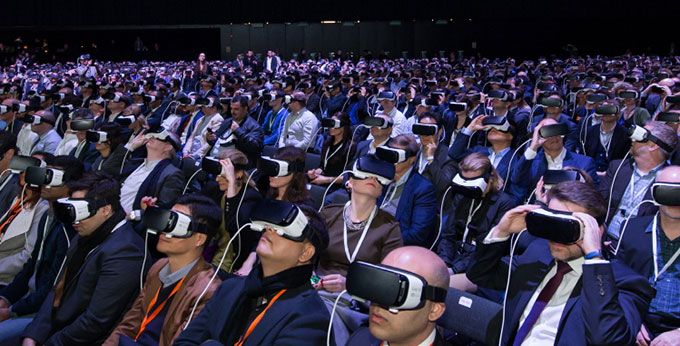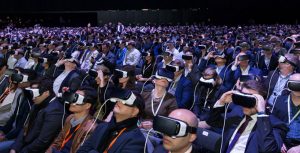
Baudry and Virtual Reality: A New Language for Cinema

Building on the works of apparatus theorists Christian Metz and Jacques Lacan, Jean Louis Baudry argues in his 1974 article, the “Ideological Effects of the Basic Cinematographic Apparatus,” that the conditions under which cinematic effects are produced influence the spectator more that the individual film itself. Baudry formulates his theories on the cinematic apparatus of the 1970s: theatrical projection. In recent years, however, new technologies mean that Baudry’s ideal relationship between spectator and screen is changing. One development in particular is live action virtual reality (VR). Live action filmmakers now have a range of tools that could revolutionize the way we experience the movies, and help filmmakers reconsider the relationship between their craft and their perceived audiences. Rather than a spectacle, a live action virtual reality film is perceived, and must, therefore, be conceived as a bodily experience.
According to Baudry, the cinematic apparatus is not just the camera and the projector, which produces the images that make up the film, but it also includes the camera operator, as well as the cinema theater. He argues that the role of film is to reproduce, through its technological bases, an ideology of idealism. An effective film, therefore, creates the illusion what is seen is “objective reality” and is so because the spectator believes he/she is the eye that calls it into being. Baudry relates the spectator’s position in cinema to Plato’s cave allegory. Plato compares human beings to prisoners in a cave who are chained in a way that only allows them to look in a single direction. Puppeteers outside of the prisoners’ field of view cast shadows on a wall. Thus, Baudry views spectators as ‘glued’ to the projection surface.
Furthermore, Baudry argues that the cinematic experience is cognitive. The spectator understands the world represented on screen as meaningful because the camera makes it so. That is, the spectator identifies less with “what is represented,” and more so with “what makes it seen:” the camera (42). Baudry argues that theatrical projection of the static images produced by the camera maintains the illusion of continuous movement in linear succession. This ensures the central position of the spectator and enables the “transcendental subject” to combine dislocated fragments into a coherent meaning he/she understands as the narrative (42).
Critiques of Baudry’s theory point out that it poses a one-way relationship between the spectator and the filmic text. Many film theorists are critical of the way the spectator is manipulated to follow a single narrative, and the underlying supposition that the spectator is an inactive victim subjected to the ideology of the filmmaker. Moreover, the relationship between spectator and cinema is thought of as purely visual. The cinematic experience, according to Baudry, therefore, presupposes the disembodiment of the spectator, and fails to address the other sensory responses that a film can stimulate.
Baudry’s conceptualization of the relationship between screen and spectator can be reworked with the introduction of Virtual Reality technologies. Live action virtual reality experiences are meant to capture the feeling of presence, which is not consumed cognitively but rather in a sensual fashion. Scenes are designed with the physical presence of spectator in mind, incorporating both visual and aural spaces.
Live-action virtual reality experiences are developed by 360-degree 3D (stereoscopic) video technologies, meaning that the cinematic apparatus is no longer theatrical projection as described by Baudry. Rather than being “chained” to the projection surface, the spectator of a virtual reality film is surrounded by the action. The action is not projected on screen, but viewed in virtual reality headsets such as Samsung Gear VR or Oculus Rift. Virtual reality goggles immerse the viewer within a scene, making him or her a part of the virtual environment.
As a spectator experiences a scene in a virtual reality headset, 360 audio follows the position of the head, always matching the direction of the sound with the position of the sound source in relation to the viewer. The spectator becomes a character in the narrative or (non-narrative). The spectator does not identify with the gaze of Baudry’s “transcendental subject,” but instead assumes the gaze by putting on a headset.
In this way, live-action virtual reality brings a new perspective to Baudry’s apparatus theory. New technologies are changing the way films are experienced, and filmmakers must reconsider the logic behind how films are made. According to Felix & Paul Studios, creators of the live action virtual reality documentary, Herders (2015), when using virtual reality technology, directors aim to erase the sense of visual manipulation. For example, filmmakers working with virtual reality try to avoid montage–the main building block of filmmaking known as “the cut”–and instead present the spectator with longer takes, similar to everyday perception. (Although, it’s thought that virtual reality works will employ manipulation of the viewer’s gaze through the use of positional audio).
Live action virtual reality will not replace classical film; it will likely be a new medium of its own. These new technologies bring new perspectives to Baudry’s apparatus theory. Virtual reality is a means to “break out” of the cinematic apparatus and the one-way relationship between screen and spectator. A film conceptualized to incorporate the physical presence of the spectator, and minimize visual manipulation is, in some ways, a response to critiques of Baudry’s theory. Live action virtual reality is an important step forward in moving the language of cinema forward in the digital age. It’s an example of the way digital media is altering, perhaps fundamentally, what it means to be a film, and of how the moving-image culture is constantly being redefined.
Comments are closed, but trackbacks and pingbacks are open.